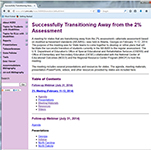Welcome
This issue of the NCEO e-newsletter includes news of the launching of the 2014 NCEO Survey of States, along with brief summaries of two new reports on accommodations on English language proficiency assessments for low-incidence disabilities. In addition, it highlights resources available from the July webinar on Successfully Transitioning Away from the 2% Assessment. Many of these resources are applicable to states seeking ways to improve use of data to identify intervention approaches, provide access to instruction, and improve implementation of standards-based IEPs. As always, we hope that you share this issue of NCEO’s e-newsletter with your colleagues.
 And, because we want to be sure that this e-newsletter meets your needs and those of your colleagues, we hope that you will take a minute to respond to a few questions about the ways in which we can improve the NCEO e-newsletter for you.
And, because we want to be sure that this e-newsletter meets your needs and those of your colleagues, we hope that you will take a minute to respond to a few questions about the ways in which we can improve the NCEO e-newsletter for you.
Resources from the NCEO Webinar on Successfully Transitioning Away from the 2% Assessment
 NCEO, with assistance from the Regional Resource Center Program (RRCP), recently held a webinar for states that are transitioning away from the 2% assessment—the alternate assessment based on modified achievement standards (AA-MAS). The materials from this webinar are available on the NCEO website that contains resources for states transitioning away from the 2% assessment.
NCEO, with assistance from the Regional Resource Center Program (RRCP), recently held a webinar for states that are transitioning away from the 2% assessment—the alternate assessment based on modified achievement standards (AA-MAS). The materials from this webinar are available on the NCEO website that contains resources for states transitioning away from the 2% assessment.
2014 NCEO Survey of States Launched!
 NCEO is pleased to announce that on September 10, 2014, it launched its biennial Survey of States. This survey, which addresses important initiatives, trends, accomplishments, and emerging issues in states relative to the participation and performance of students with disabilities in state assessment and accountability systems, is the 14th survey of states that NCEO has conducted over the past 24 years.
NCEO is pleased to announce that on September 10, 2014, it launched its biennial Survey of States. This survey, which addresses important initiatives, trends, accomplishments, and emerging issues in states relative to the participation and performance of students with disabilities in state assessment and accountability systems, is the 14th survey of states that NCEO has conducted over the past 24 years.
 New Reports on Accommodations on English Language Proficiency Assessments for Students with Low-Incidence Disabilities
New Reports on Accommodations on English Language Proficiency Assessments for Students with Low-Incidence Disabilities
Including students with low-incidence disabilities (e.g., students who are blind and students who are deaf) on all domains of an English language proficiency (ELP) assessment can be challenging. For example, how is reading in English measured for students who are blind and typically access text through braille? Similarly, how is listening in English measured for students who are deaf and usually receive information communicated orally through American Sign Language (ASL) or closed captioning? These are challenges that state departments of education have addressed through accommodations policies for ELP assessments. Two new NCEO publications address accommodations on ELP assessments.
